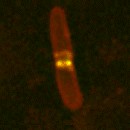Waves make bug break point

Formation of the Z ring as an E. coli cell divides. <br>© Qin Sun/University of Texas <br>
Sloshing proteins help bacteria find their waists.
Chemical waves may help a bacterium to divide by pinpointing its middle, according to a new model of protein interactions1.
Bacteria such as Escherichia coli multiply by dividing. Bacterial division (called binary fission) is simpler than human cell division (mitosis). Human cells erect scaffolding to transport components to the two nascent daughter cells at either end; bacteria just pinch in two.
Within this simplicity lies a puzzle. Without sophisticated molecular machinery, how do bacteria organize themselves so that their daughter cells are of roughly equal size?
Martin Howard of Simon Fraser University in Burnaby, British Columbia, and colleagues think that the key is in the sloshing of three proteins, MinC, MinD and MinE, from end to end of the bacteria. This Min family initiates the formation of a protein drawstring, the Z ring, that runs around the cell’s midpoint and contracts to form a narrow waist.
In an E. coli cell, the Min proteins interact, setting up waves that sweep from end to end with a period of about 1-2 minutes. MinC and MinD gather at the cell’s ends, MinE gathers in the middle. MinC disrupts Z-ring formation, so the ring appears only at the midpoint, where the MinC concentration is low.
Howard’s team has devised a mathematical model of the Min family’s interactions. The model shows that the proteins’ oscillations can produce standing waves, like the air waves in an organ pipe, with MinE concentrated in the cell’s middle and MinC and D at the ends.
A similar interplay between reacting and diffusing proteins during development is thought to be responsible for some animals’ stripes. If Min proteins were coloured, a dividing bacterium would be dark at each end with a light band in the middle.
The researchers say that reasonable assumptions about the rates of protein reactions and diffusion give the right single-band form – two bands of MinE, for example, would result in a cell being pinched into three daughter cells. But they acknowledge that these rates have not yet been measured accurately enough to test the model stringently.
References
- Howard, M., Rutenberg, A. D. & de Vet, S. Dynamic compartmentalization of bacteria: accurate division in E. coli. Physical Review Letters, 87, 278102, (2001).
Media Contact
More Information:
http://www.nature.com/nsu/011220/011220-7.htmlAll latest news from the category: Life Sciences and Chemistry
Articles and reports from the Life Sciences and chemistry area deal with applied and basic research into modern biology, chemistry and human medicine.
Valuable information can be found on a range of life sciences fields including bacteriology, biochemistry, bionics, bioinformatics, biophysics, biotechnology, genetics, geobotany, human biology, marine biology, microbiology, molecular biology, cellular biology, zoology, bioinorganic chemistry, microchemistry and environmental chemistry.
Newest articles
Faster, more energy-efficient way to manufacture an industrially important chemical
Zirconium combined with silicon nitride enhances the conversion of propane — present in natural gas — needed to create in-demand plastic, polypropylene. Polypropylene is a common type of plastic found…

Energy planning in Ghana as a role model for the world
Improving the resilience of energy systems in the Global South. What criteria should we use to better plan for resilient energy systems? How do socio-economic, technical and climate change related…

Artificial blood vessels could improve heart bypass outcomes
Artificial blood vessels could improve heart bypass outcomes. 3D-printed blood vessels, which closely mimic the properties of human veins, could transform the treatment of cardiovascular diseases. Strong, flexible, gel-like tubes…




















